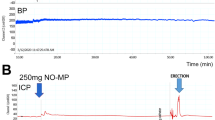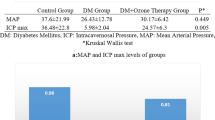Abstract
Phosphodiesterase (PDE) inhibitors represent an important advance in the treatment of erectile dysfunction (ED). In spite of widespread use and generally good efficacy, as a class they remain ineffective in 15–57% of men. Specific cohorts of patients with severe vascular or neurogenic basis to their ED, such as diabetic men or those who have undergone radical pelvic surgery, demonstrate lower response rates with PDE inhibition treatment. We believe that circulating levels of nitric oxide (NO) may be enhanced through delivery of adequate concentrations of free oxygen radical scavenger molecules such as vitamin E. Higher levels of NO, theoretically, should produce increased penile blood flow with the potential for a synergistic effect when combined with a PDE5 inhibitor. With this hypothesis in mind, 20 adult male Sprague–Dawley streptozotocin-induced (60 mg/kg i.p.) diabetic rats were divided into four therapeutic groups (n=5). Group I—control animals received peanut oil, group II—vitamin E 20 IU/day, group III—sildenafil 5 mg/kg/day and group IV—vitamin E 20 IU/day plus sildenafil 5 mg/kg/day, by oral gavage daily for 3 weeks. Erectile function was assessed as a rise in intracavernous pressure following cavernous nerve electrostimulation. Penile tissue was harvested to determine the changes in tissue morphology including neuronal nitric oxide synthase, smooth muscle α-actin and endothelial cell integrity. PDE5 protein content and activity were measured. Significant increases in intracavernous pressure were measured in the animals receiving combined vitamin E plus sildenafil treatment. Immunohistochemical staining showed increases of neuronal nitric oxide synthase, endothelial cell and smooth muscle cell staining. Western blot analysis did not show significant differences of PDE5 protein between the groups. However, higher PDE5 activity was measured in the sildenafil group and lower activity of PDE5 was recorded in the cohort receiving vitamin E with sildenafil. Vitamin E enhanced the therapeutic effect of the PDE5 inhibitor in a meaningful way in this animal model of diabetes. This study indicates a potential means of salvaging erectile function among patients who are refractory to sildenafil.
This is a preview of subscription content, access via your institution
Access options
Subscribe to this journal
Receive 8 print issues and online access
$259.00 per year
only $32.38 per issue
Buy this article
- Purchase on Springer Link
- Instant access to full article PDF
Prices may be subject to local taxes which are calculated during checkout




Similar content being viewed by others
References
Benet AE, Melman A . The epidemiology of erectile dysfunction. Urol Clin N Am 1995; 22: 699.
Maatman TJ, Montague DK, Martin LM . Erectile dysfunction in men with diabetes mellitus. Urology 1987; 29: 589–592.
Hakim LS, Goldstein I . Diabetic sexual dysfunction. Endocrinol Metab Clin N Am 1996; 25: 379–400.
Kolodny RC, Kahn CB, Goldstein HH, Barnett DM . Sexual dysfunction in diabetic men. Diabetes 1974; 23: 306–309.
McCulloch DK et al. The prevalence of diabetic impotence. Diabetologia 1980; 18: 279–283.
Rendell MS, Rajfer J, Wicker PA, Smith MD . Sildenafil for treatment of erectile dysfunction in men with diabetes: a randomized controlled trial. Sildenafil Diabetes Study Group. JAMA 1999; 281: 421–426.
Andersson KE, Aagner G . Physiology of penile erection. Physiol Rev 1995; 191–236.
Moreland RB, Hsieh G, Nakane M, Brioni JD . The biochemical and neurologic basis for the treatment of male erectile dysfunction. J Pharmacol Exp Ther 2001; 296: 225–234.
Abderrahmane A et al. Direct activation of K(Ca) channel in airway smooth muscle by nitric oxide: involvement of a nitrothiosylation mechanism? Am J Respir Cell Mol Biol 1998; 19: 485–497.
Bolotina VM, Najibi S, Palacino JJ, Cohen RA . Nitric oxide directly activates calcium-dependent potassium channels in vascular smooth muscle. Nature 1994; 368: 850–853.
Cooke JP, Tsao PS . Cytoprotective effects of nitric oxide. Circulation 1993; 88 (Part 1): 2451–2454.
Beckman JS, Koppenol WH . Nitric oxide, superoxide, and peroxynitrite: the good, the bad, and the ugly. Am J Physiol Cell Physiol 1996; 271: C1424–C1437.
Burnett AL et al. Nitric oxide: a physiologic mediator of penile erection. Science 1992; 257: 401.
Saenz De Tejada I et al. Impaired neurogenic and endothelium-mediated relaxation of penile smooth muscle from diabetic men with impotence. N Engl J Med 1989; 320: 1027.
Escrig A et al. Changes in mating behavior, erectile function, and nitric oxide levels in penile corpora cavernosa in streptozotocin-diabetic rats. Biol Reprod 2002; 66: 185–189.
Tesfamariam B, Cohen RA . Free radicals mediate endothelial cell dysfunction caused by elevated glucose. Am J Physiol 1992; 263 (Part 2): H321–H326.
Baynes JW, Thorpe SR . Role of oxidative stress in diabetic complications. A new perspective on an old paradigm. Diabetes 1999; 48: 1–9.
Katusic ZS . Superoxide anion and endothelial regulation of arterial tone. Free Radic Biol Med 1996; 20: 443–448.
Montorsi F et al. Efficacy and safety of fixed-dose oral sildenafil in the treatment of erectile dysfunction of various etiologies. Urology 1999; 53: 1011–1018.
Wallis RM, Corbin JD, Francis SH, Ellis P . Tissue distribution of phosphodiesterase families and the effects of sildenafil on tissue cyclic nucleotides, platelet function, and the contractile responses of trabeculae carneae and aortic rings in vitro. Am J Cardiol 1999; 83: 3C–12C.
Ballard SA et al. Effects of sildenafil on the relaxation of human corpus cavernosum tissue in vitro and on the activities of cyclic nucleotide phosphodiesterase isozymes. J Urol 1998; 159: 2164–2171.
Giuliano F, Pena BM, Mishra A, Smith MD . Efficacy results and quality-of-life measures in men receiving sildenafil citrate for the treatment of erectile dysfunction. Qual Life Res 2001; 10: 359–369.
Padma-Nathan H, Steers WD, Wicker PA . Efficacy and safety of oral sildenafil in the treatment of erectile dysfunction: a double-blind, placebo-controlled study of 329 patients. Sildenafil Study Group. Int J Clin Pract 1998; 52: 375–379.
Burton GW, Ingold KU . Vitamin E: application of the principles of physical organic chemistry to the exploration of its structure and function. Acc Chem Res 1986; 19: 194–201.
Willson RL . Free radical protection: why vitamin E, not vitamin C, beta-carotene or glutathione? Ciba Found Symp 1983; 101: 19–44.
Islam KN, Devaraj S, Jialal I . α-Tocopherol enrichment of monocytes decreases agonist-induced adhesion to human endothelial cells. Circulation 1998; 98: 2255–2261.
Saldeen T, Li D, Mehta JL . Differential effects of alpha- and gamma-tocopherol on low-density lipoprotein oxidation, superoxide activity, platelet aggregation and arterial thrombogenesis [In Process Citation]. J Am Coll Cardiol 1999; 34: 1208–1215.
Mabile L, Bruckdorfer KR, Rice-Evans C . Moderate supplementation with natural alpha-tocopherol decreases platelet aggregation and low-density lipoprotein oxidation. Atherosclerosis 1999; 147: 177–185.
Park JY, Ha SW, King GL . The role of protein kinase C activation in the pathogenesis of diabetic vascular complications. Periton Dial Int 1999; 19: S222–S227.
Kinlay S et al. Plasma alpha-tocopherol and coronary endothelium-dependent vasodilator function. Circulation 1999; 100: 219–221.
Keegan A, Walbank H, Cotter MA, Cameron NE . Chronic vitamin E treatment prevents defective endothelium-dependent relaxation in diabetic rat aorta. Diabetologia 1995; 38: 1475–1478.
Karasu C et al. Antioxidant and triglyceride-lowering effects of vitamin E associated with the prevention of abnormalities in the reactivity and morphology of aorta from streptozotocin-diabetic rats. Antioxidants in Diabetes-Induced Complications (ADIC) Study Group. Metabolism 1997; 46: 872–879.
Spoto G et al. A reverse-phase HPLC method for cAMP phosphodiesterase activity. Anal Biochem 1991; 196: 207–210.
Miller MA et al. Hydrolysis of cyclic guanosine monophosphate and cyclic adenosine monophosphate by the penis and aorta of the diabetic rat. Br J Urol 1996; 78: 252–256.
Perimenis P et al. Switching from long-term treatment with self-injections to oral sildenafil in diabetic patients with severe erectile dysfunction. Eur Urol 2002; 41: 387–391.
Tsujimura A et al. The clinical studies of sildenafil for the ageing male. Int J Androl 2002; 25: 28–33.
Thompson CS et al. The effect of sildenafil on corpus cavernosal smooth muscle relaxation and cyclic GMP formation in the diabetic rabbit. Eur J Pharmacol 2001; 425: 57–64.
Lang D et al. Homocysteine-induced inhibition of endothelium-dependent relaxation in rabbit aorta: role for superoxide anions. Arterioscler Thromb Vasc Biol 2000; 20: 422–427.
Pathania V, Syal N, Pathak CM, Khanduja KL . Changes in rat alveolar macrophageal antioxidant defense and reactive oxygen species release by high dietary vitamin E. Nutr Sci Vitaminol (Tokyo) 1998; 44: 491–502.
Mayes PA . Structure and function of the lipid-soluble vitamins. In: Murray RK, Granner DK, Mayes PA, Rodwell VW (eds). Harper's Biochemistry, 25th edn. Appleton & Lange: Stamford, CT, 2000, 649pp.
Corbin JD, Turko IV, Beasley A, Francis SH . Phosphorylation of phosphodiesterase-5 by cyclic nucleotide-dependent protein kinase alters its catalytic and allosteric cGMP-binding activities. Eur J Biochem 2000; 267: 2760–2767.
Gopal VK, Sharron H, Francis S, Corbin JD . Allosteric sites of phosphodiesterase-5 (PDE5). A potential role in negative feedback regulation of cGMP signaling in corpus cavernosum. Eur J Biochem 2001; 268: 3304.
Okada D, Asakawa S . Allosteric activation of cGMP-specific, cGMP-binding phosphodiesterase (PDE5) by cGMP. Biochemistry 2002; 41: 9672–9679.
Burns F, Rodger IW, Pyne NJ . The catalytic subunit of protein kinase A triggers activation of the type V cyclic GMP-specific phosphodiesterase from guinea-pig lung. Biochem J 1992; 283 (Part 2): 487–491.
Burchardt T et al. Reduction of endothelial and smooth muscle density in the corpora cavernosa of the streptozotocin induced diabetic rat. J Urol 2000; 164: 1807–1811.
Akingba AG, Burnett AL . Endothelial nitric oxide synthase protein expression, localization, and activity in the penis of the alloxan-induced diabetic rat. Mol Urol 2001; 5: 189–197.
el-Sakka AI et al. Effects of diabetes on nitric oxide synthase and growth factor genes and protein expression in an animal model. Int J Impot Res 1999; 11: 123–132.
Gonzalez-Perez O et al. Beneficial effects of alpha-lipoic acid plus vitamin E on neurological deficit, reactive gliosis and neuronal remodeling in the penumbra of the ischemic rat brain. J Neurosci Lett 2002; 321: 100–104.
Shite J et al. Antioxidant vitamins attenuate oxidative stress and cardiac dysfunction in tachycardia-induced cardiomyopathy. J Am Coll Cardiol. 2001; 38: 1734–1740.
Evans JL, Goldfine ID, Maddux BA, Grodsky GM . Oxidative stress and stress-activated signaling pathways: a unifying hypothesis of type 2 diabetes. Endocr Rev 2002; 23: 599–622.
Author information
Authors and Affiliations
Corresponding author
Rights and permissions
About this article
Cite this article
De Young, L., Yu, D., Freeman, D. et al. Effect of PDE5 inhibition combined with free oxygen radical scavenger therapy on erectile function in a diabetic animal model. Int J Impot Res 15, 347–354 (2003). https://doi.org/10.1038/sj.ijir.3901026
Accepted:
Published:
Issue Date:
DOI: https://doi.org/10.1038/sj.ijir.3901026
Keywords
This article is cited by
-
Influence of lauric acid on the relaxation of corpus cavernosum in streptozotocin-induced diabetic male Wistar rats
Future Journal of Pharmaceutical Sciences (2022)
-
Atorvastatin improves erectile dysfunction in patients initially irresponsive to Sildenafil by the activation of endothelial nitric oxide synthase
International Journal of Impotence Research (2013)
-
Therapeutic effect of combination of alagebrium (ALT-711) and sildenafil on erectile function in diabetic rats
International Journal of Impotence Research (2012)
-
Daily use of phosphodiesterase 5 inhibitors for erectile dysfunction and lower urinary tract symptoms
International Journal of Impotence Research (2008)
-
Reactive oxygen species and erectile dysfunction: possible role of NADPH oxidase
International Journal of Impotence Research (2007)



